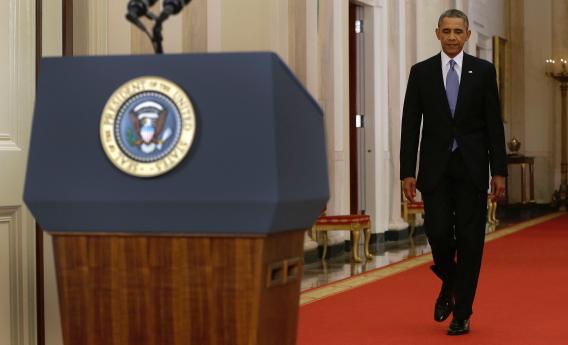My Slate colleagues will soon have more to say about the political implications of tonight’s speech by President Obama. From my perspective, there didn’t seem to be a whole lot of new information for those who’ve been following the debate over Syria, and indeed several lines seemed to be directly lifted from statements made in the last few weeks.
Overall, it seemed like a speech that had been written two days ago in order to justify a military strike on Bashar al-Assad’s military and was amended at the last minute to indefinitely postpone such action until the Russian diplomatic proposal currently on the table plays itself out.
From a rhetorical point of view, one thing that struck me was the repeated reference to the images and videos of the victims of the Aug. 21 chemical attack:
The images from this massacre are sickening: men, women, children lying in rows, killed by poison gas, others foaming at the mouth, gasping for breath, a father clutching his dead children, imploring them to get up and walk.[…]
The world saw thousands of videos, cell phone pictures, and social media accounts from the attack, and humanitarian organizations told stories of hospitals packed with people who had symptoms of poison gas.[…]
To my friends on the left, I ask you to reconcile your belief in freedom and dignity for all people with those images of children writhing in pain and going still on a cold hospital floor, for sometimes resolutions and statements of condemnation are simply not enough.
Indeed, I’d ask every member of Congress and those of you watching at home tonight to view those videos of the attack, and then ask, what kind of world will we live in if the United States of America sees a dictator brazenly violate international law with poison gas and we choose to look the other way?
The remarks echoed recent statements from Secretary of State John Kerry, who has said that, “Those videos make it clear to people that these are real human beings, real children, parents being affected in ways that are unacceptable to anybody, anywhere by any standards.” Though there have been no shortage of horrific images and stories coming out of Syria over the last two years, the images in question are undeniably disturbing.
In a month where the lessons of the 1990s seem to be trotted out with striking frequency, this seems like a time to revisit one of the most popular international relations concepts of that decade: the CNN effect. The idea was that the 24-hour news cycle and the easy availability of footage of the world’s most horrific atrocities would increasingly drive the decisions of American policymakers. The textbook example was Somalia, where televised images of starving children galvanized U.S. support for intervention and images of the bodies of American troops being dragged through the streets of Mogadishu turned the public solidly against the mission.
The notion of a CNN effect feels a bit quaint in the YouTube era, but the idea seems worth revisiting now. Obama and Kerry appear to be appealing to one aspect of the effect—the idea that the U.S. public can’t afford to ignore atrocities when the victims appear in gruesome detail on the nightly news, or in this case, all over social media.
But there’s another side to the effect, that also seems pertinent in light of topsy-turvy events and seemingly seat-of-the-pants decision-making of the last few days: the idea that the instant availability of provocative imagery and the resulting public reaction creates an environment where reasoned, informed decision-making is extremely difficult.
Former Secretary of State James Baker described the effect this way: “The one thing it does is to drive policymakers to have a policy position. I would have to articulate it very quickly. You are in a real-time mode. You don’t have time to reflect.”
Former U.N. Secretary General Kofi Annan was reflecting on the international community’s response to Bosnia in the 1990s but he could have been describing the Obama administration’s response to recent events in Syria when he said that ‘When governments have a clear policy, they have anticipated a situation and they know what they want to do and where they want to go, then television has little impact” but “when there is a problem, and policy has not been thought through, there is a knee-jerk reaction. They have to do something or face a public relations disaster.”
The Obama administration has not appeared to have a thought-through policy for Syria in the last few days and has indeed seemed to have been pushed from one course of action to another by the pressure to “do something.” The key difference this time is that this pressure has not come from the public, which has only become more skeptical of U.S. intervention as the administration has made its case and doesn’t seem swayed by the images coming out of Syria.
In the case of Syria’s chemical weapons victims, the CNN effect—or YouTube effect, or Twitter effect if you prefer—appears to largely be an inside-the-White House phenomenon.
